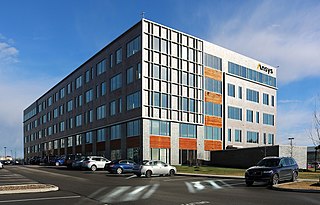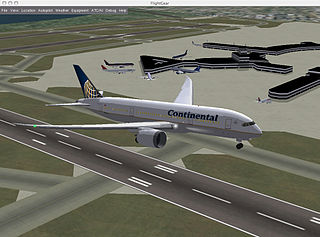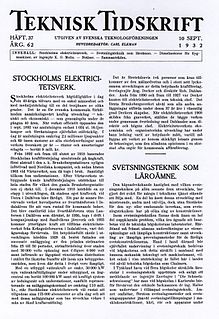Related Research Articles

A simulation is the imitation of the operation of a real-world process or system over time. Simulations require the use of models; the model represents the key characteristics or behaviors of the selected system or process, whereas the simulation represents the evolution of the model over time. Often, computers are used to execute the simulation.

A train simulator is a computer based simulation of rail transport operations. They are generally large complicated software packages modeling a 3D virtual reality world implemented both as commercial trainers, and consumer computer game software with 'play modes' which lets the user interact by stepping inside the virtual world. Because of the near view modeling, often at speed, train simulator software is generally far more complicated and difficult software to write and implement than flight simulator programs.
Sim (simulated) racing or racing simulation are the collective terms for racing game software that attempts to accurately simulate auto racing, complete with real-world variables such as fuel usage, damage, tire wear and grip, and suspension settings. To be competitive in sim racing, a driver must understand all aspects of car handling that make real-world racing so difficult, such as threshold braking, how to maintain control of a car as the tires lose traction, and how properly to enter and exit a turn without sacrificing speed. It is this level of difficulty that distinguishes sim racing from "arcade" style driving games where real-world variables are taken out of the equation and the principal objective is to create a sense of speed as opposed to a sense of realism.

Ansys, Inc. is an American company based in Canonsburg, Pennsylvania. It develops and markets CAD/CAM and multiphysics engineering simulation software for product design, testing and operation and offers its products and services to customers worldwide. Ansys was founded in 1970 by John Swanson who sold his interest in the company to venture capitalists in 1993. Ansys went public on NASDAQ in 1996. In the 2000s, the company acquired numerous other engineering design companies, obtaining additional technology for fluid dynamics, electronics design, and physics analysis. Ansys became a component of the NASDAQ-100 index on December 23, 2019.
Virtutech was founded in 1998 as a spin-off from the Swedish Institute of Computer Science (SICS), in Stockholm, Sweden. In 2004, the headquarters was moved to San Jose, California, USA. The Stockholm site remains the company's R&D center. The company's main product is Simics software, used by teams of software developers to simulate computer systems. This facilitates the development, testing, and debugging of embedded software that runs devices such as high-end servers, network hardware, aerospace/military vehicles, and automobiles. Virtutech markets products that allow embedded software developers to create virtual models of hardware using an ordinary desktop computer, run specified sets of tests, and walk the programs through each step of execution, both forwards and backwards. See the Simics Wikipedia article for more on the product.

A robotics simulator is a simulator used to create application for a physical robot without depending on the actual machine, thus saving cost and time. In some case, these applications can be transferred onto the physical robot without modifications.

IMINT Image Intelligence AB, often called Imint AB, is a software company providing smartphone manufacturers with video analysis software under the trade mark Vidhance with headquarters in Uppsala, Sweden.
Vortex Studio is a complete simulation software platform. It features a high-fidelity, realtime physics engine developed by CM Labs Simulations that simulates rigid body dynamics, collision detection, contact determination, and dynamic reactions. It also contains model import and preparation tools, an image generator, and networking tools for distributed simulation, accessed through a desktop editor via a GUI. Vortex adds accurate physical motion and interactions to objects in visual-simulation applications for operator training, mission planning, product concept validation, heavy machinery and robotics design and testing, haptics devices, immersive and virtual reality (VR) environments.

Algodoo is a physics-based 2D sandbox freeware from Algoryx Simulation AB as the successor to the popular physics application Phun. It was released on September 1, 2009 and is presented as: a learning tool, an open ended computer game, an animation tool, and an engineering tool.
SimCraft, a privately held company headquartered just outside Atlanta, Georgia, is the creator of a proprietary motion simulation technology and manufactures simulation equipment integrating this technology, including professional driver in the loop racing simulators. The motion simulator technology, in development since 1998, is designed to recreate the manner in which vehicles move in earth physics. The company offers a range of simulator products in the category of motion simulation that provide a tactile true motion experience for Motorsport Simulation and flight simulation. The company's core innovation and technology is the simulation of vehicle movement through proprietary physics based software interfaces and a patent pending hardware architecture based on Center of Mass principles of motion. The company's product applications range principally by variation in chassis design and material and are found in usage from military training/research, professional training, to individual simulation and gaming enthusiast entertainment.

Amateur flight simulation refers to the simulation of various aspects of flight or the flight environment for purposes other than flight training or aircraft development. A significant community of simulation enthusiasts is supported by several commercial software packages, as well as commercial and homebuilt hardware. Open-source software that is used by the Aerospace industry like FlightGear, whose flight dynamics engine (JSBSim) is used in a 2015 NASA benchmark to judge new simulation code to space industry standards, is also available for amateur use. A popular type of amateur flight simulators are combat flight simulators, which simulate combat air operations from the pilot and crew's point of view. Combat flight simulation titles are more numerous than civilian flight simulators due to variety of subject matter available and market demand.

rFactor 2 is a computer racing simulator developed by the American independent software firm Image Space Incorporated and released for Windows in 2012. Like its predecessor, rFactor, it is designed to be modified and is used by professional racing teams for driver training and race car development. Much of its source code is derived from rFactor Pro which is also used by professional racers and most of the Formula One teams and NASCAR manufacturers.
CarSim is a commercial software package that predicts the performance of vehicles in response to driver controls in a given environment. CarSim is produced and distributed by an American company, Mechanical Simulation Corporation, using technology that originated at the University of Michigan Transportation Research Institute (UMTRI) in Ann Arbor, Michigan.

Algoryx Simulation AB was formed in 2007 in Umeå, Sweden as a spin-off company from Umeå University. Algoryx currently has three products: Algodoo, Dynamics for SpaceClaim, and AGX Multiphysics, a professional physics engine for engineering and real-time simulations.
Ny Teknik is a weekly Swedish magazine with news, debates and ads in the field of technology and engineering. It is published in Stockholm, Sweden.
MAK Technologies, formerly doing business as VT MAK, Inc. is a software company based in Cambridge, Massachusetts that provides commercial off-the-shelf (COTS) modeling and simulation software. The company develops and sells software for distributed simulations that system integrators, governments, and research institutions use to build and populate 3D simulated environments. Users include medical, aerospace, defense, and transportation industries. In addition to offering COTS software, MAK provides the following services: simulation content creation, software customization, interoperability, research and development, and training.
CM Labs Simulations is a private company established in Montreal in 2001. CM Labs is the developer of the Vortex simulation platform. The Vortex platform is composed of applications for creating interactive vehicle and mechanical equipment simulations in virtual environments. Vortex simulates rigid body dynamics, collision detection, contact determination, and dynamic reactions. CM Labs also manufactures crane and heavy equipment simulators based on Vortex technology.

Teknisk Tidskrift, was founded in 1871 by the Swedish marine engineer Wilhelm Hoffstedt (1841–1907). The forerunner to Ny Teknik, it has since its establishment been considered one of the leading journals in Sweden for the publication of findings in technology and engineering.
References
- ↑ "Algoryx Simulation to represent Swedish innovation on world tour". Archived from the original on 2011-09-01.
- ↑ "Next generation innovations to place Sweden on the map". Archived from the original on 2011-04-07.
- ↑ "List of Sweden's hottest tech companies 2011 (Affärsvärlden)". Archived from the original on 2011-04-02. Retrieved 2011-04-20.
- ↑ "List of Sweden's hottest tech companies 2011 (Ny Teknik)".
- ↑ "Technologies that have changed the world of sport".